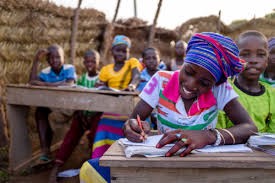THE CRISIS IN GHANA EDUCATION SYSTEM
Chapter 4 - The Reforms of the 1980's

With the assistance of several development partners (World Bank, Department for International Development (ODA) and international grants) the education system was reviewed and proposals were implemented in 1987.
A brief summary of the objectives of the implemented actions: - Increase access to basic education - Shorten the pre-university education structure from 17 years to 12 years. - Make education cost-effective
- Improve quality of education by making it more effective to socio
-economic conditions
The Junior Secondary School structure was put in place on a nation wide basis. Now 6 years of primary education and 3 years of junior secondary school were a standard 9 years of free and compulsory basic education. The reforms saw further changes from hours spend at school to educational resources such as infrastructure of class blocks and libraries, school supplies and technical skills equipment.
Although the reforms helped to solve some of the problems, the results achieved by students at the primary school level were low. The government then embarked on the BESIP/FCUBE (Basic Education Sector Improvement or more popular- the Free Compulsory, Universal, Basic Education Program) program, which was aimed at providing every child of school-going age with good basic education.
Some of the objectives of the FCUBE program were:
- Improving the quality of learning and teaching
- Improving access to basic education facilities
The Tertiary Education sector also underwent reforms.
By 1979 Ghana had 3 Universities with a number of research institutions and professional associations. The main objectives of the reforms were to improve quality, efficiency, access, equity, relevance and sustainability.
